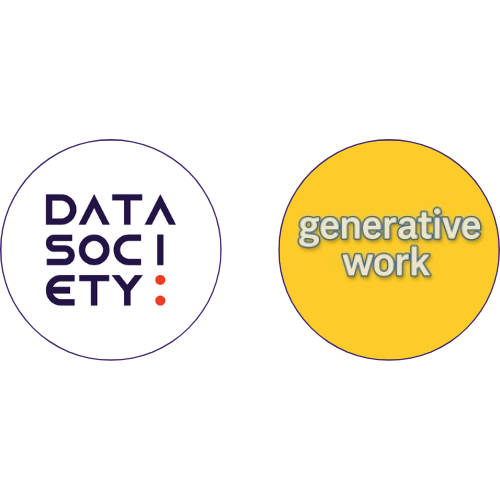Why do so many learning programs fall flat? One reason is that they’re often designed around compliance, not curiosity. When the phrase “mandatory training” enters the conversation, learner motivation usually drops before the training even begins.
“Even the word ‘mandatory training’ strikes fear in the heart of everybody who has to go through those,” says Meghan Cipperley, SVP of Learning at Data Society. “There are a lot of perceived motivators that are automatically non-starters for many learners.”
The key to reversing that trend lies in shifting the learning model from something that’s done to people to something done for and with them. According to Cipperley, it starts with tapping into what truly drives learners, their intrinsic motivation, and building learning experiences that feel personal, flexible, and purposeful.
This approach reflects foundational adult learning principles, which stress the importance of relevance, respect, and self-direction. Adults bring a lifetime of experience to the table, and they’re more engaged when training acknowledges that. The most effective programs invite participation, not compliance.
LEARN MORE: The AI Learning Gap: Why Teams Struggle to Apply What They Learn
The Adult Learning Principles: What’s in It for Me?
Intrinsic motivation in adult learners is often grounded in relevance and autonomy. “It’s about making sure that you approach the learner where their motivation truly is going to ignite a fire,” she explains. “What is in it for me as an adult learner? How can I improve, upskill, or even prevent the loss of skills or promotion value at my workplace?”
That sense of relevance is what separates effective learning from checkbox compliance. When people understand the personal and professional value of a course, they lean in. This mirrors the foundations of adult learning theory, which stress the importance of self-direction and real-world application (Park University).
Learning That Fits—Not Fights—Your Day

But understanding motivation isn’t enough—you also have to build around it. “Anything that a learner can do to learn at their own pace” matters, Cipperley notes. That might look like asynchronous formats, modular content, or mobile-first design. In other words, learning that fits, not fights, the rhythm of their day.
This aligns with key principles of adult learning, which emphasize relevance, autonomy, and practicality. Adults learn best when they can immediately apply what they’re learning to real-world tasks, and when they feel in control of the pace and format. Respecting their time and experience isn’t just thoughtful design; it’s a smart strategy.
Passion and Purpose in Practice
The most successful learning experiences, she says, connect directly to work that matters. “It really applies to their environment, what they’re passionate about,” she adds. That might mean creating communities of practice or opportunities to test academic concepts in the workplace. It could also mean creating capstone projects that let employees apply what they’ve learned in tangible, meaningful ways.
“Make sure they’re applying all of the learning at the company,” she explains. “Managers then get to see the results of what they’ve been investing in. It fulfills that circle—we see the results, we see it’s great for you, and again that pushes back into getting everybody else excited.”
It’s not just about keeping learners engaged. It’s about showing stakeholders that learning initiatives drive impact.
Adding Fun: Gamification That Works
Cipperley also sees a role for gamification, but not in the traditional, surface-level sense. “One of the funnest ones has been a little bit of gamification,” she shares, referencing friendly competitions and creative applications of content. Think less about earning points and more about low-stakes experimentation. “When you’re in a learning environment, play and fun and experimentation—that is gamification.”
This kind of engagement can be especially powerful when tied to real work. And it doesn’t hurt to include incentives, either.
It also aligns with core adult learning principles, which emphasize relevance, problem-solving, and self-directed exploration. By creating opportunities for experimentation and immediate application, gamification taps into what adults need most: learning that feels useful, empowering, and worthwhile.
Removing Barriers to Motivation
Still, even the best-designed programs can stumble if barriers remain. “How can barriers be removed?” Cipperley asks. That might mean removing logistical challenges, addressing psychological safety, or creating clearer pathways for recognition.
Learners need to feel seen, supported, and rewarded—not just for completing modules, but for applying knowledge and growing in their roles. “How can I be recognized for those things?” she poses. “How can I be supported for those things?”
The answer lies in rethinking how we structure, deliver, and measure learning. Instead of starting with content and pushing it out, we need to start with the learner and work backward. We need to ask: What motivates this person? What do they need to succeed? And how can we build something that makes them want to come back for more?
Final Takeaway: Make Learning Personal—and Practical
“When you show people the why and let them experience the win,” says Cipperley, “motivation stops being a problem.”
Looking to build a culture of curiosity in your organization? Data Society helps teams design learning experiences that stick—through flexible delivery, meaningful application, and programs built for how adults actually learn. Grounded in adult learning principles like relevance, autonomy, and immediate application, our approach turns training into transformation. Contact us to learn more.
Q&A: From Compliance to Curiosity in Learning and Development
Organizations can shift by designing training with learners, not for them. This means tapping into intrinsic motivation—focusing on relevance, flexibility, and real-world application. Learning should feel personal, purposeful, and empowering.

